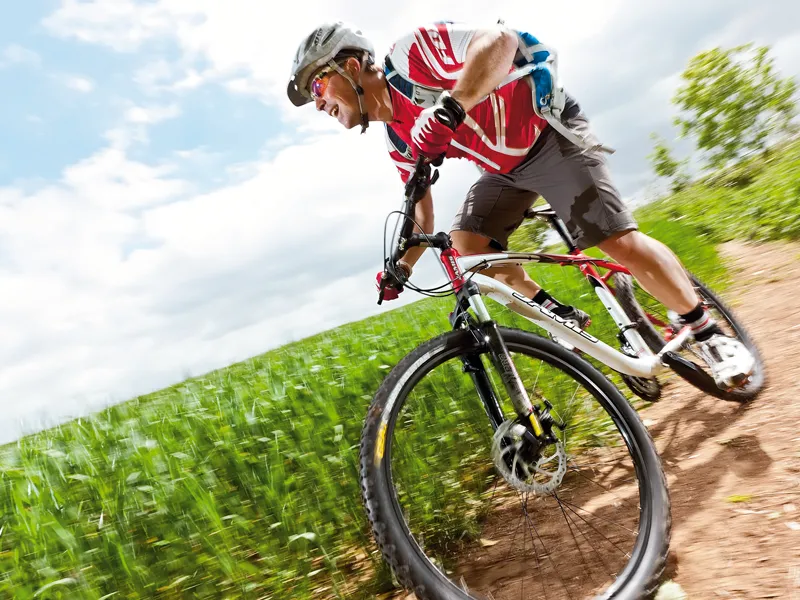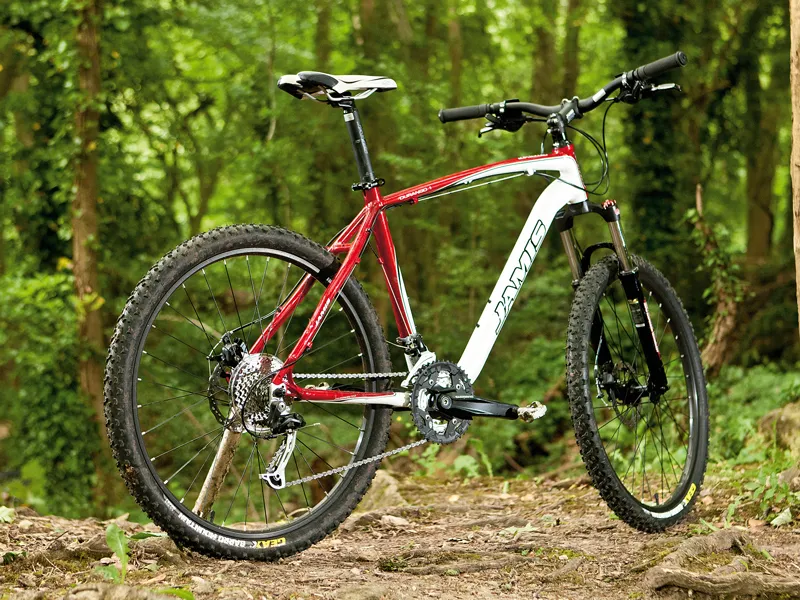Jamis is an established US brand that’s now imported into the UK by Evans. We chose it for this test because it looks like a well equipped good value machine with a frame that’ll take better components when stuff starts wearing - not that there’s anything wrong with the components it already has.
The only obvious downgrade compared to some other bikes in this price-range is that it has cable disc brakes instead of hydraulics. The Durango 1 is a good value bike that feels comfortable and confident on and off road. While hydraulic disc brakes and a better fork would improve it considerably, at this price we’re not complaining. It was the lightest and most popular, in terms of ride feel, in a test with other similarly priced hardtails. The icing on the cake is the fact that it comes with 27 gears, and a 34-tooth sprocket on the cassette.
Ride & handling: Lively acceleration with comfortable, confident off-road performance
The nicely balanced ride position of the Durango creates a very confident feel on the trail. The overall wheel and tyre weight is slightly less than on the other three bikes, and that helps to create a more lively acceleration and climbing personality. While the Shimano Alivio-based drivetrain is a step downmarket from the Shimano Deore found on a couple of the Jamis' peers, shifting remained slick and efficient. There were times on the steepest climbs when we really appreciated the 34-tooth biggest sprocket on the nine-speed cassette.
Tektro’s cable pull discs initially offer almost as much braking power and a softer lever feel than hydraulics, but the cabling is prone to dirt and water ingress in poor trail conditions so they’ll need more frequent maintenance than sealed hydraulic hoses. Overall handling was incredibly confident on all types of terrain. Considering its price tag it’s a remarkably easy bike to take through the rougher sections of twisty singletrack that dominate much of our local test routes.
The fork is a limiting factor as the speed increases and bumps come faster, and the rear gear kept banging up onto the underside of the chainstay whenever we were freewheeling rough descents in the big ring. A couple of riders felt the need for a wider bar than the 24.5in one fitted, but most felt it was a decent compromise for a bike that’s going to spend a lot of its life in urban environments.
Frame & equipment: A sub-30lb weight and 27 gears are climbing bonuses on a bike at this price
The curved frame shape of the Durango is a love/hate thing. In theory straighter tubes are lighter but, as one of the lightest bikes in this price-range, it seems almost futile to mention that. It’s impossible to tell whether the big ‘S bend’ down tube or slightly bowed top tube profile provide an advantage to the ride feel, but we suspect probably not compared to more obvious factors like the tyres.
Our only gripe is that the bared gear cables look a bit odd hanging under the top tube: full outers might have been a more elegant solution. The general finishing detail of the frame is excellent. The down tube has gusset reinforcement behind the head tube, there are two sets of bottle cage bosses and rack mounts and there’s plenty of room for bigger treads than the grippy Geax 2.1in Barro Mountains fitted if you want more comfort.
Comfort is pretty good already though: a soft padded saddle, decent grips and a good backsweep on the 24.5in riser bar all conspire to flatter the rangey, well-centred ride posture and confident, neutral geometry. RST’s Gila Pro fork isn’t great but the undamped rebound thunk is less harsh than most forks on £450 bikes and the initially very stiff compression feel seemed to loosen slightly towards the end of the test period, but still only giving about 70mm of the theoretical 100mm of travel on offer.
Some riders prefer the softer lever pull of cable disc brakes compared to the on/off feel of many low budget hydraulic brakes. But that has to be countered against the fact that cable pulls are more likely to suffer from dirt or moisture ingress in poor conditions. They’re more maintenance hungry than hydraulics. The move to a 34 or a 36-tooth cassette sprocket happened with the trend towards two rings instead of three up front. But it’s good to see such a wide sprocket range with triple rings. Staying in the middle ring on climbs is a boost to confidence and fitness.
There aren’t many forks left with a cantilever brake option. It’s often a sign of old-stock fork legs, but at least it leaves you with an option of rim brakes if the wheel rims can take it. Unfortunately the Jamis doesn’t have cantilever brake bosses at the back, so you’re stuck with discs.

